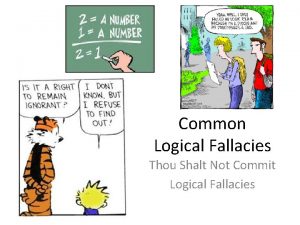To Commit or Not to Commit How Attachment

- Slides: 1

To Commit or Not to Commit: How Attachment and Trust Relate to Commitment in Dating Couples Jaclyn Theisen & Brian Ogolsky University of Illinois at Urbana-Champaign Introduction & Background Attachment and Benevolent Trust Secure • • Trust and commitment are essential elements of romantic relationships. Attachment, however, influences the processes of commitment and trust in romantic relationships. • People who are securely attached have higher levels of trust than people with insecure attachments (Collins & Read, 1990). • Individuals with avoidant attachment show more reluctance to commit because they reject closeness and avoid self-disclosure (Wei, Russell, & Zakalik, 2005). • Attachment anxiety, however, is less clear and has been shown to be both positively and negatively associated with commitment (Feeney & Noller, 1990). • Ambivalence may be one reason the association between attachment anxiety and commitment is unclear because past research has not separated these attachment orientations. However, ambivalence is related to difficulty committing (van Harreveld, Rutiens, Rotteveel, Nordgren, & van der Pligt, 2009). Researchers have found that trust mediates the relationship between attachment and relationship quality, thus finding insecure attachment to be associated to lower levels of trust as well as lower levels of relaitonship quality (Givertz et al. , 2013). The current study, informed by attachment theory and past research, will examine how attachment is associated with trust and commitment. Anxious Avoidant 0. 15 • Trust and commitment are both essential ingredients to the continuation of a romantic relationship. Stronger feelings of commitment are related to stronger feelings of psychological attachment and to long-term orientation (Rusbult, Martz, & Agnew, 1998). Further, lack of trust in a relationship is associated with more fluctuations in relationship quality (Campbell, Simpson, Boldry, & Rubin, 2010). • Attachment orientations may influence trust and commitment to the relationship. • When an individual has a secure attachment it is easier for her to commit or trust her partner, however, when an individual is not securely attached this process is harder. By understanding how attachment is related to trust and commitment we can inform couples on how to work on these foundational elements of the relationship to promote the maintenance and continuance of the relationship. • Further, although individuals with insecure attachments tended to have lower scores on trust and commitment it did not mean that trust and commitment were not important. Trust and commitment may just take longer to form in relationships in which one or both individuals has an insecure attachment. • However, by understanding the relationship between attachment, trust, and commitment we can begin to understand how these factors influence romantic relationships. 0. 1 0. 05 0 Mean • Ambivalent Discussion -0. 05 -0. 15 -0. 25 ** Attachment and Honest Trust Secure Ambivalent Anxious Avoidant 0. 15 0. 1 0. 05 Method • • • The sample consisted of a random sample of 232 dating couples (N = 464). Participants were recruited through random digit dialing from a large southwestern city. All participants were never-married, dating someone of the opposite sex, and aged 19 to 35. Participants had been in their current romantic relationship for approximately 2 years (M = 26. 30 months, SD = 21. 77). Participants were 24 years old on average (Men M = 24. 80, SD = 3. 86; Women M = 23. 26, SD = 3. 58). Ethnicity: White (69%), Hispanic (17%), African American (7%), and Asian American or Other (7%). Mean 0 -0. 05 -0. 15 -0. 25 ** -0. 3 Attachment and Global Commitment Future Directions 6. 80 Measures • • Relationship Questionnaire (Bartholomew & Horowitz, 1991) The Dyadic Trust Scale (Larzelere & Huston, 1980) • “I feel that my partner can be counted on to help me. ” • Benevolent Trust: M = 0, SD = 0. 86 • “My partner is perfectly honest and truthful with me. ” • Honest Trust: M = 0, SD = 0. 92 Global Commitment (Rusbult, 1980) • “Do you feel committed to maintaining your relationship with your partner? ” • M = 6. 53, SD = 1. 68 Relationship Satisfaction (Huston & Vangelisti, 1991) • “All things considered, how satisfied or dissatisfied have you been with your relationship over the last month or so? ” • M = 0, SD = 0. 97 • 6. 60 • 6. 50 Mean • • 6. 70 • 6. 40 ** ** 6. 30 • Examine the relationship between attachment, trust, and commitment during relationship transitions. Look at how attachment, trust, and commitment work in online dating relationships. Do other factors influence the relationship between attachment, trust, and commitment? How does an individual’s attachment, trust, and commitment in the relationship influence the communication between partners? 6. 20 6. 10 6. 00 Secure Ambivalent Anxious Avoidant Contact Information Jaclyn Theisen jctheis 2@Illinois. edu ** Indicates significant difference from secure ACKNOWLEDGEMENTS:

